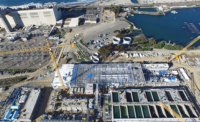Desalination Advocates are Pinning Hopes on New Plant in Carlsbad










Many hopes are riding on the new $1-billion, 54-million-gallon-a-day seawater desalination plant and pipeline in Carlsbad, Calif. If successful, the project, made possible through one of the first public-private partnerships of its kind in the U.S., could serve as a model for other projects around the country.
If the project falters, however, the growing momentum for similar U.S. seawater desalination projects could face a reversal, industry observers say.
"It is being watched closely right now," says Peter MacLaggan, senior vice president of Poseidon Water, the Boston company that is partnering with the San Diego Water Authority to fund and build the project. "If we were to stub our toe and come out of the shoe with a plant that is not performing well, it's going to be a major setback" for desalination projects in the U.S., he says. Nevertheless, "We're very confident that this project will be a model when it's completed."
Seawater desalination has been long accepted as a way to increase freshwater supplies in arid nations, such as Australia, Israel and the U.A.E., and in countries with limited sources of drinking water, such as Singapore. Worldwide, there are some 14,754 desalination plants in operation, producing about 17.2 billion gallons a day, according to IDE Technologies Ltd., a leading designer of desalination plants.
But in the U.S., the use of desalination has been limited by higher costs and concerns over excessive energy consumption. Population growth and drought associated with climate change may alter that, however, as municipalities grapple with the need for more sources of clean drinking water.
"The U.S. has been blessed compared to many other parts of the world in that [it has] had a lot of other [freshwater] supplies that were less expensive to provide to the public," says Rudy Truby, the International Desalination Association's comptroller. "What's happening now is, as population has grown, many of the high-growth places in California, Texas and Florida, where there isn't an excess of surface water or well water … are having to turn to the sea."
Jujung Chang, director of water technologies at Los Angeles-based AECOM and formerly at Omaha, Neb.-based HDR, adds that, as the cost of reverse-osmosis membranes has declined with continuing technology advancements, interest in desalination and other reverse-osmosis processes has increased in the U.S. Most of that price drop, due to technology advancements, already has reached its lowest point, "even though [overall] costs are [still] reducing as we speak," he says.
The Carlsbad plant, when completed by the end of 2015, would be the largest reverse-osmosis seawater desal plant in the Western Hemisphere and the second sizable reverse-osmosis desalination project to be built in the U.S.
The first—a 25-mgd plant built in Apollo Beach, Fla., in 2008—was plagued by difficulties, including years of construction delays, the bankruptcy of several original developers and contractors, and an initial failure to operate as expected. Utility Tampa Bay Water subsequently sued many of the parties involved.
After beginning operations nearly four years behind schedule, the plant now is functioning as planned, providing about 10% of the region's annual water supply, says Tampa Bay Water.
To oversee the building of the plant, Poseidon Resources, now Poseidon Water, was part of the original team led by contractor Stone & Webster, which filed for bankruptcy in 2000 and later was bought by The Shaw Group. Then, Covanta Tampa Construction, a now-bankrupt unit of Covanta Energy, was hired to execute the project but soon ran into performance problems.








